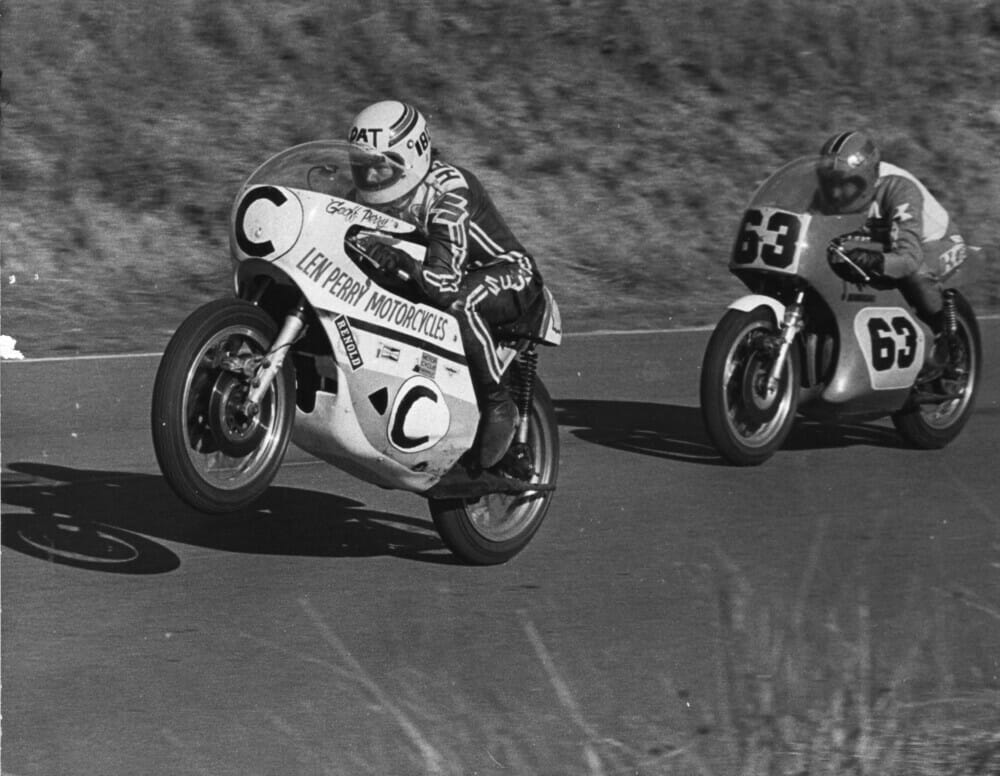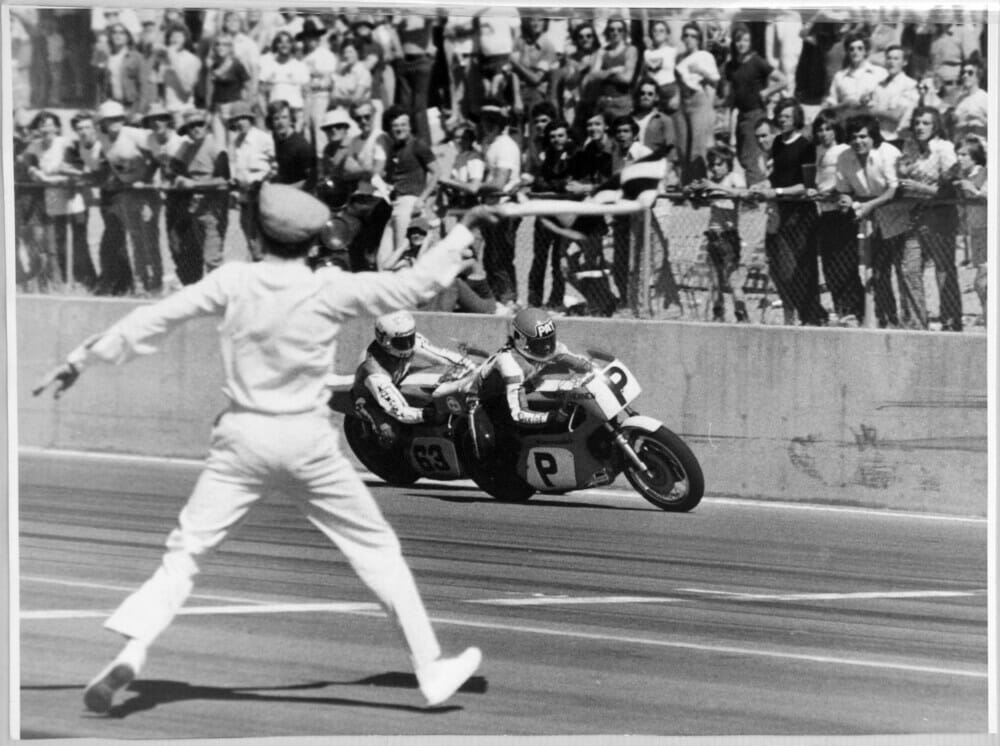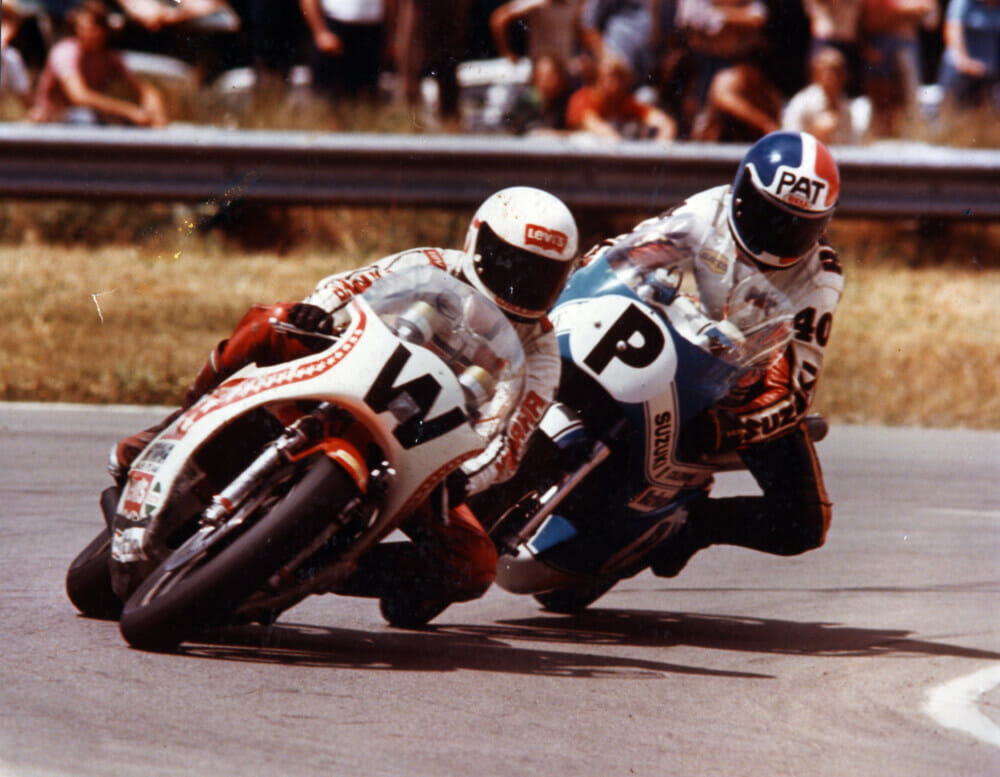Rennie Scaysbrook | July 17, 2022
Cycle News Archives
COLUMN
Pat Hennen in Australia
In a road-racing career that lasted just six short years, Pat Hennen’s star shone brilliantly until that fateful day in the Isle of Man, just minutes after he had set the first-ever sub-20-minute lap.
Hennen had ex-pat Brit racer Ron Grant to thank for opening the doors that led rapidly to some plum rides, but there was also a very strong Down Under influence in his formative star racing years.
Through the Coleman family, Suzuki importers in New Zealand, some highly competitive Suzukis came his way for the NZ Marlboro International Series, run over the Christmas/New Year period, which he won three years in succession from 1975 to 1977.
 Over the second “hump” on Conrod Straight, Pat Hennen leads Australian veteran Ron Toombs. Photos: Independent Observations Archives
Over the second “hump” on Conrod Straight, Pat Hennen leads Australian veteran Ron Toombs. Photos: Independent Observations Archives
His first year in NZ was the 1972/’73 season, prior to the advent of the Marlboro Series where he rode what was called the Sayonara Special, a Suzuki TR500-based bike built by John Allnatt. But while the Kiwi series was hard-fought, it was mainly on small tracks (the longest being Pukekohe at 2.5 miles), and in the Southern Hemisphere, the big daddy of all circuits was Mount Panorama at Bathurst, three hours west of Sydney.
Mount Panorama came into being in 1938 and thereafter became the annual Easter destination for the cream of Australasian racers and tens of thousands of spectators. By the early ’70s, Mount Panorama was undergoing a transformation from a traditional battleground for the old British singles and twins, to a venue for the very latest Japanese rocket ships. In 1974, that meant Formula 750.
The four-mile lap included a steep climb up the mountain with an equally precipitous descent onto the quaintly named but ferociously fast Conrod Straight, coined for its ability to thunderously extract the internals of many an engine. That straight contained two humps that sent front wheels soaring on the new generation 750s and required a big heart to prevent the right hand from easing the throttle.
Held just a few weeks after Daytona, where the TZ750 Yamahas arrived to monster the Suzuki and Kawasaki 750 triples, Easter Bathurst was a vastly different place to what it had been before. No fewer than 11 of the new Yamahas were entered for the main race, the Unlimited Grand Prix over 20 laps, including one for Hennen’s mentor Ron Grant.
Australia’s top two riders, Gregg Hansford and Warren Willing, had both competed at Daytona on their new Yamahas, and started as hot favorites. Ranged against the Yamahas were Kawasaki H2Rs for veteran Ron Toombs and Kiwi Ginger Molloy, plus the NZ-built Suzuki TR750, with Hennen in the saddle. The Suzuki had been built by chassis wizard Steve Roberts, with finance from Rod Coleman, and in Geoff Perry’s incredibly capable hands it was a highly competitive machine. When 23-year-old Perry lost his life in an airplane crash in July 1973, the TR750 was initially mothballed until it was decided to bring it, and Hennen, to Bathurst for Easter 1974.
 Hennen winning the final race and the Pan Pacific Series from Toombs in Adelaide 1975.
Hennen winning the final race and the Pan Pacific Series from Toombs in Adelaide 1975.
There were actually three races on the program for the fancy new 750s, beginning with the Formula Unlimited, held over two rounds of eight laps. Typically, most practice sessions had been wet, leaving precious little time for the dry setup to suit the weekend’s fine conditions. In race one on Saturday morning, Hennen defied the odds to blast through from a terrible start to snatch second place behind Hansford, and ahead of Willing—and nine other TZ750s. Race two on Sunday morning saw Hansford win again, this time from Willing, with Hennen on the rostrum in third place after again blowing the start.
There wasn’t a spare spot on the fence around the circuit as the field for the premier Unlimited GP lined up on Sunday afternoon. This time Hennen finally managed to get the Suzuki off the line cleanly, and he was right with the leaders as the first lap was completed.
The field soon broke into two groups, with Hansford and Willing all over each other, and Hennen exchanging blows with Toombs—the rest of the packed field increasingly further behind. For the entire 20 laps, Hansford and Willing swapped places, as did Hennen and Toombs, but the long race (and the 190 mph speeds on Conrod Straight) were punishing the Suzuki’s rear tire.
With a handful of laps to go, Pat glanced the safety fence exiting the final corner onto the start/finish straight. There was nothing for it but to let Toombs go as he nursed the disintegrating rubber to the finish. Judging that corner to perfection on the final run to the line, Willing beat Hansford by half a length, setting a new outright lap record of 2:23.35—nine seconds faster than the previous mark and just shy of the magic 100-mph lap average.
 Hennen harries Warren Willing at Ruapuna in the 1976/77 Marlboro Series in NZ.
Hennen harries Warren Willing at Ruapuna in the 1976/77 Marlboro Series in NZ.
That race went into the books as one of the most thrilling in the history of the circuit and is still talked about today. And although Willing and Hansford grabbed the bulk of the cash (the richest purse in Australian racing), Pat Hennen covered himself in glory and set himself on a path to stardom that would see him become the first American Grand Prix winner, in Finland, in 1976.
Despite his growing concentration on the European scene, Hennen remained a familiar figure in Australia, contesting the Pan Pacific Series in late 1974 on a Kawasaki borrowed from fellow American Hurley Wilvert and winning the series on the very last corner of the final race in Adelaide after yet another race-long battle with 41-year-old Toombs.CN